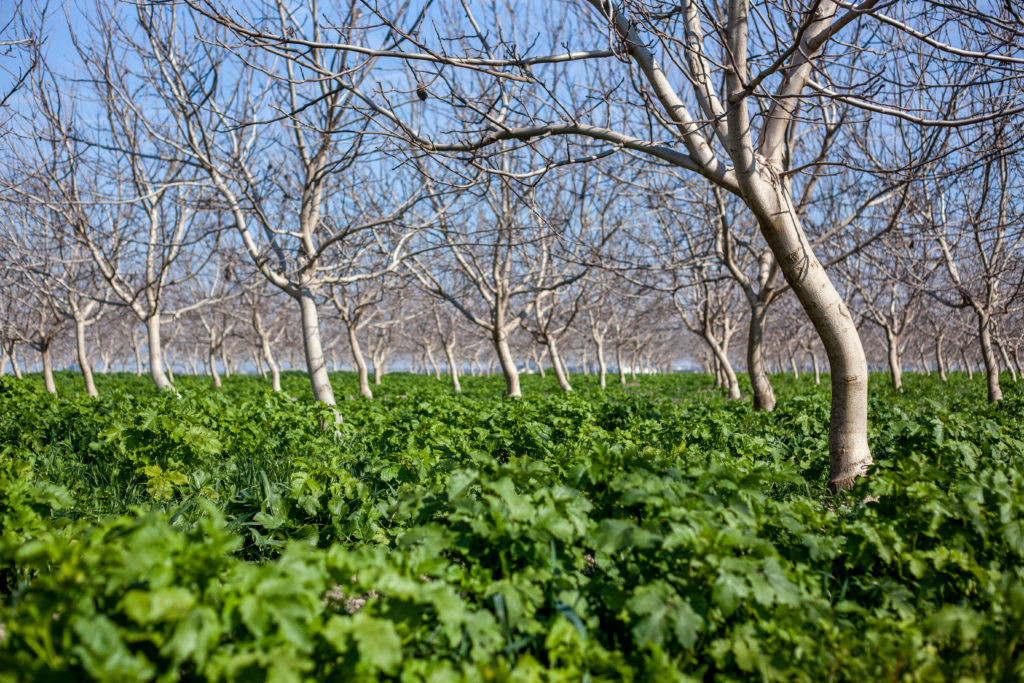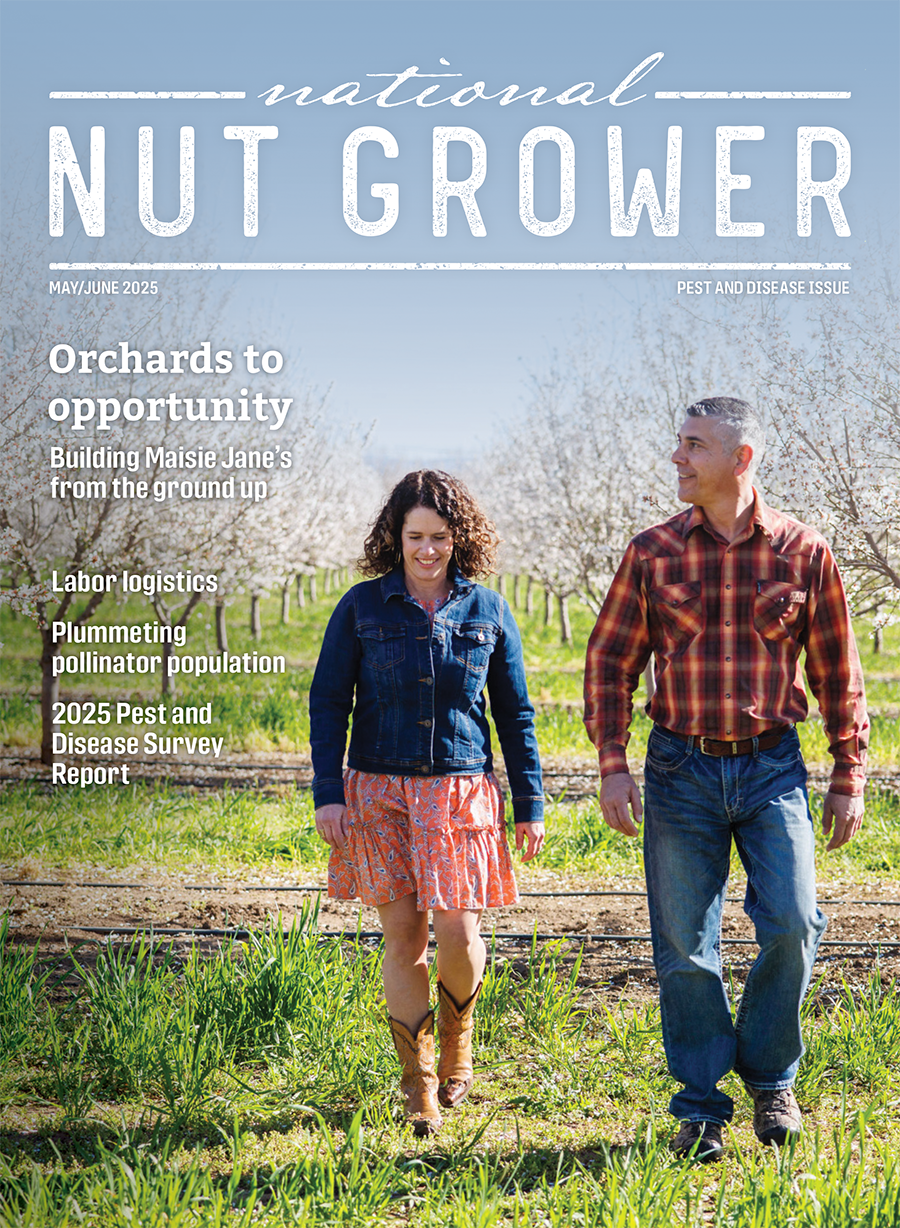
Mar/Apr 2022
Prescriptive cover crops
Cover crops are gaining in popularity, not simply as a trendy ancient practice made new again, but because – when it’s all said and done – it works.
It took some time, convincing, and observing of the neighbor’s cover crop results, but Stephen Maloney, foreman for Zonneveld Farms, was able to get the go-ahead on the planting of cover crops a couple years ago. With the help of Cary Crum, agronomist with California Ag Solutions, the two were able to turn a block of walnuts in Hanford, California, into a more balanced and eco-friendly system that required fewer to no sprays, less water, kept the orchard temperatures cooler, and invited beneficials. But underneath this all is the key to what cover crops bring – improved soil health.
“It’s called equilibrium,” said Crum. “Nature wants to be in balance.”
Prescriptive cover crops
This farm in particular is flood irrigated and, like so many others, had issues with water infiltration just two seasons ago. The tree stress was visible, as was the water sitting for days in the field. It was this issue that led Maloney to try a cover crop.
“We noticed a big difference in the water the first year,” said Maloney. “And now, there’s plenty of moisture in the ground, even though it hasn’t rained. It made management this past season easier because we didn’t have to water it constantly.”
The increased water infiltration had a domino effect for the orchard, including better nutrient cycling, which made better use of the fertility plan. The increase in organic matter increased water holding capacity, which allowed for better use of the water and more time between irrigation applications. It was a favorable outcome in the regularly water-strapped Central Valley of California.

“It’s important to look at cover cropping from an agronomic standpoint,” Crum said. “Before you plant, have a management plan. What’s the problem you’re trying to solve? What season do you want to plant, and where are you located? How are you going to mow, and when will you terminate the cover crop, and how are you adjusting your fertility program?”
Part of that planning, however, is the selection of seed mix. While organizations provide a few bulk mix options containing a few varieties of seed, Crum recommends a custom mix containing anywhere from 8-15 seed types for broader diversity and to target specific purposes.
“We call it prescriptive cover crops,” said Crum. “Everything is custom blended for a reason, and we see exponential benefits with over eight species of plants. Let it go as long as it can into the season, and big benefits start to happen.”
“Last year, we didn’t spray this field at all,” said Maloney.
The Hanford field has 15 different types of plants in its mix, even if not all of them express themselves. Soil conditions can vary, and some species of the mix do better in different areas of the same orchard. The added cost of the custom blend has been worth it, and Zonneveld Farms has doubled the walnut acreage on which the mix is used.

Animal integration
It has taken some time to bring growers back around to the idea of improving soil health through cover cropping, and animal integration may see the same – if not more – hesitation towards implementation. But at this Zonneveld block, the flock is in full swing cleaning up the cover crop.
“This does equally as good a job as a mower, but with way more benefits,” said Crum. “There are certain microbial properties in a ruminant’s saliva that stimulate plant growth during the process of grazing. Also, people think the manure is the benefit of the sheep, but it’s the urine.”
The ruminant eats the cover crop at a specific location and processes it through its body, where plant enzymes are extracted and – with added biology – are ultimately urinated back onto the ground, explained Crum. This urine is a stimulant for the site-specific, local microbes, which in turn provide what the plants need based on the plants and microbial community present.
With over 400 sheep in this block and about 1,600 more on the way, the fences are set until the cover crop reaches a certain height, after which the fences are then moved and the sheep introduced into a new section. It’s a managed graze controlled by zone. The sheep will get two passes in a section until May, when they’re required to be removed for food safety reasons with a minimum 120-day requirement before harvest.
The harvest conundrum is another reason growers may be hesitant about planting a cover. Maloney has experienced outright refusal from a harvester.
“Someone threatened not to harvest almonds because there was some residue left,” Maloney said. “He thought all these nuts would be left behind, but there was no difference in harvest.”
Aside from soil benefits and no changes in harvest, the bonus is that growers with lush and nutritious cover crops can receive a premium for animal integration. Tree nut farmers are paid so many cents per day, per animal, and can reach as much as $40-$55 per acre, covering the cost of the custom-blended cover crop seed.
It’s a symbiotic relationship, as the sheep experience lower death rates, and ewes can simultaneously nurse their lambs and still gain weight, which doesn’t happen with other crops, such as alfalfa.
“Implement this big of a change in an orchard and everything changes,” said Crum of cover crops. The implementation of sheep is the next big step. “It’s a really neat system, I just wish we could get more people to do it.”
Above photo: The custom-blended cover crop in walnut in Hanford, California. Photo: Matt Hannon









